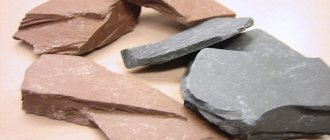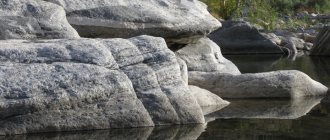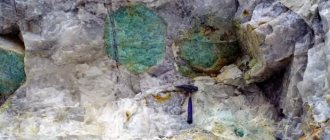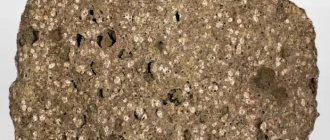- Reports
- The world
- Marble mineral
Marble is a rock whose main constituent is calcium. Marble is a mineral that is formed from limestone as a result of the influence of physical and chemical processes of nature.
Marble consists not only of calcium, it contains many different impurities that affect its color. The predominance of iron gives marble a red color, silicates - green, manganese - brown.
Natural deposits of this rock can be found throughout our country of Russia. The very first deposits where man began to mine this rock are considered to be deposits located in Karelia. The deposits located in the Urals are considered to be the largest in terms of production volumes of this mineral. Marble deposits exist in Western Siberia and Altai; their number is known to be more than fifty, but mining is carried out only on three.
This breed has found great use in construction since ancient times. This rock is used for making various monuments, tombstones, and tombstones. During the construction of buildings, marble is used for cladding both the external walls of the building and the interior. In electrical equipment, marble boards are widely used in electrical distribution boards, electrical appliance panels. Crushed marble chips are the main component of the plaster used to cover the walls and ceilings of buildings. Marble is in great demand for decorating fountains, home fireplaces, stairs, flowerpots, and gazebos in gardens.
Marble is a very strong and hardy rock, so ancient marble products have been preserved at present, which indicates the special exclusivity of this mineral among other rocks.
One of the advantages of this breed is that marble can be polished well. This is a very durable stone, has high resistance to frost and humidity, has great durability, and does not absorb radiation.
The disadvantages of this rock include the fact that the marble surface quickly becomes dirty in everyday life. He does not like any acid, the color of marble is not uniform.
But, despite its shortcomings, marble will always be in demand by people, now and in the future, for its beauty and durability.
What is marble
In geology, it is a crystalline-grained mineral formed during the metamorphism of carbonate rocks (limestones or dolomites) under the influence of high pressures and temperatures. In the construction industry, “marble” often means any durable, polishable limestone or non-carbonate (for example, silicate) rocks. But true, metamorphogenic marble is precisely limestone that has undergone contact or regional metamorphism, when individual calcite crystals become larger at the expense of others. As a result, the rock acquires a granular structure, which is clearly visible on a fresh fracture. Actually, this is one of the characteristic features of “real” marble.
Natural marble can only be obtained after complete recrystallization of limestone. If the process has not been completed, the result is marbled limestone. Externally, it can be distinguished by the presence in the composition of various fossils (in real marble this is extremely rare and only in areas that have undergone metamorphism to a lesser extent). In terms of its properties (porosity, density, moisture capacity), marbled limestone is close to ordinary marble.
Fact 3: The Egyptians loved to use marble in their pyramids
Surely, you have seen photos of the majestic golden Egyptian pyramids in the deserts. Many people don't know that some of them were previously lined with white marble. The builders of the ancient civilization carved and installed polished slabs of white limestone onto the more massive pyramids. For the small pyramids, they used beige marble. Ancient Egyptian temples were decorated with large marble blocks and columns, but during the Caliphate, people dismantled them to decorate the decoration of mosques. This is why Egyptian writing can be found on the marble panels of ancient mosques.
Types of marble
The pure breed is snow-white in color and is quite rare. This is a statuary, fine-grained type of stone that is used in sculptural art. Even a small percentage of impurities significantly affects the color of the stone, and the shade can vary within one deposit or even block.
In nature there are yellow, pink, blue, greenish, reddish and even black shades. Colored rocks are characterized by a large number of veins - these are cracks filled with natural cements.
The value of marble is often determined by its color:
- White sculpted marble. It is a homogeneous rock with a fine-grained structure and high ductility, making this type of stone easy to cut and grind.
- Blue (blue) is one of the most valuable breeds. The blue tint of marble is given by blue diopside, a mineral also known as violane.
- Black - contains a high percentage of bitumen or graphite impurities. Rare, expensive, extremely spectacular variety. Rocks with a blue tint contain inclusions of iron sulfides.
- Beige - contains inclusions of manganese and limonite (brown iron ore).
- Red is a valuable variety, rich in iron oxides. The more impurities in the composition, the richer the color. Pink marble, accordingly, has a lower percentage of oxides.
- Brown - this shade is obtained due to the presence of manganese and iron carbonate in the composition.
- Green – this shade is given to marble by inclusions of chlorites.
Message 2
Marble is a metamorphic rock, translated from Greek means shining stone, consisting of calcite. Widely distributed in various spheres of life: from agriculture to construction. It has different colors and is a very beautiful rock. Occurs from the interaction of limestone and dolmite under certain geological conditions.
General information about marble:
The options for using this breed are very wide:
Where else is marble used:
Location of marble
It is mined in many regions of Russia, but the largest marble mining area is the Urals. In total, there are more than 20 places where this rock originated, but, unfortunately, only 8 deposits have the opportunity to extract stone. Who would have thought, but there is marble on Lake Baikal too.
The location of this product directly affects its color: the Irkutsk region gives the stone a reddish tint, the Pushtulim mining site gives the stone a white color, and the Gramatushinsky place is the birthplace of the lilac-pink stone. Each place where stone is mined has its own structure of the earth, minerals, and so on. Due to this, the color of the marble changes.
People don’t think about how widely known and widespread this type of stone is. It is present everywhere, in many different forms. This is a very beautiful and colorful stone that can not only decorate, but also carry some useful functions. It can decorate not only window sills and tabletops. Marble plays the main decorative role of various castles, palaces and cultural objects, adding grandeur and luxury. It is difficult to find a replacement for such a multi-functional breed. Although marble is not so hard and is not a precious rock or stone, it can even be turned into sand, but it is useful and can be used in life in absolutely any form, which not every rock can boast of.
Properties of marble
Marble is a strong, durable and temperature-resistant stone. During mechanical processing, the material retains its original structure: it does not peel off, does not break, and does not form internal cracks. Thanks to this, it is possible to create exquisite bas-reliefs and sculptures from marble. The stone is practically not subject to temporary changes and is able to maintain its original appearance for 150 years or more.
Here it should be clarified that the feasibility of using marble for exterior work in large industrial cities is highly doubtful. The fact is that all carbonate-type rocks are subject to intense weathering due to exposure to exhaust gases, including automobiles.
The low coefficient of water absorption (0.15-0.50%) allows this stone to be used for finishing bathrooms, fountains, and swimming pools. Due to the fact that marble practically does not absorb moisture, it is quite frost-resistant. Thawing-freezing cycles do not affect its internal structure, so it is often used for finishing facades.
Characteristics of marble:
- Density – 1.9-2.8 g/cm³. For comparison, the density of granite is 2.6 g/cm³.
- Specific gravity - depends on density and impurities. 1 m³ of marble weighs on average 2300-2600 kg.
- Hardness on the Mohs scale is 2.5-3. Corresponds to the hardness of gold and silver. Marble can be easily scratched with a knife. For comparison, the hardness of granite on the Mohs scale is 8 points.
- Abrasion – 0.40 to 3.20 g/cm². This is the third group of abrasion, which also includes loose basalts and sandstones. If you make a marble staircase in your personal apartment, it will wear down by 0.02 mm annually and will last 500 years.
Marble is known for its high mechanical strength. According to this indicator, it exceeds concrete by 2-2.5 times. Thanks to its thread-like structure, this stone is able to withstand high static and dynamic loads. And even if you break a marble tile, the break line will not have sharp edges and can be easily polished.
Disadvantages of marble:
- Due to its high abrasion, marble is not suitable for flooring in areas with high passenger traffic. Dust and dirt will quickly make the stone unsightly.
- The material is vulnerable to acidic environments. Upon contact with hydrochloric acid, the stone completely dissolves with the release of carbon dioxide. It is recommended to use alkaline detergents to care for marble surfaces.
- The heterogeneity of structure and shades complicates the selection of identical colors for finishing large areas.
Recommendations for stone care
Keeping marble products clean and tidy is quite simple. To do this, you need to have a soft cloth and a piece of suede on hand. The cloth should be moistened in warm water, wrung out a little and wiped over the stone surface. A small piece of suede will be needed for polishing.
It is recommended to clean natural stone once every six months using special detergents. You can use dishwashing detergent after diluting it slightly with water. After cleaning, it is advisable to periodically apply polish to the surface of the product. This protective coating, which has dust-repellent properties, will help maintain the attractive appearance of the stone.
If greasy stains appear on it, you should deal with them carefully. Sometimes traces of mold form on products. We are talking about those stones that are exposed to the open air for a long time. Fungal microorganisms are eliminated using a non-concentrated chlorine solution. The composition of marble does not allow the use of substances containing abrasive components and various acids when caring for it. It is not allowed to clean marble stone with metal or plastic brushes or a vacuum cleaner.
Regular adherence to these simple rules will ensure that products made from excellent natural materials will retain their properties and will please the eye for a long time.
Source
Marble mining
As a rule, marble is mined by open-pit mining in a similar way to limestone. During the mining process, it is important to prevent the appearance of cracks in the rock mass and maintain its integrity, therefore explosive methods of stone extraction are not practiced (unlike the same limestone). There are three modern methods of quarrying stone:
- Rope stone cutting machines. Blocks of marble are separated using a special diamond-coated cable that performs reciprocating movements. Massive blocks are removed by heavy cranes.
- Circular saws. Used to mine small and medium sized blocks. The smaller the diameter of the disk, the smaller the blocks. During operation, the saw blade is watered with a mixture of water and sand - this achieves the required level of friction.
- Burocline method. Wells are drilled into the rock mass using industrial hammer drills, then air or liquid is pumped into them under pressure, which splits the rock along the intended lines. The quality of the blocks obtained in this way is noticeably lower compared to cutting.
The choice of method depends on the characteristics of the deposits. For example, in the Ural deposits, where 8 deposits out of 20 known are being developed, stone is mined using stone-cutting machines, and in Karelia, where red and pink varieties are common, they use the “silent explosion” method with a hydrocline.
The blocks extracted from the depths are delivered to a stone-cutting factory, where the stone is cut and polished. Subsequently, the surface of the block is polished using oxalic acid, which softens the surface and allows you to achieve perfect shine.
Popular topics today
Africa is a large and unique continent, so many scientists and scientists consider it a full-fledged and large nature reserve. Due to the location of the mainland
The Arctic fox is a predator, a mammal from the canine family and from the genus of foxes. The arctic fox is also called the polar fox. Outwardly, this animal is very similar to a fox. In contrast, the arctic fox has a squat stance
Interesting insects are cockroaches. An order of arthropod parasites that are very common in the world.
Igor Emmanuilovich Grabal is a painter and art theorist who was born in the seventies of the last century in Hungary. His father was Emmanuel Grabar, who became famous as a public
The ear is an integral and one of the main parts of our general body. With the help of the ear, we perceive, recognize sound impulses and understand everything that the world around us tells us.
Source
Use of marble
The scope of application of marble is extremely wide. Sculptures, original tableware and lamps, mosaic panels and tiles are made from it. Stone is also actively used for exterior and interior decoration of buildings. Due to its high heat resistance, marble is suitable for cladding fireplaces.
White marble is an excellent dielectric with high electrical insulating properties. Due to this, it is used in the electrical industry in the manufacture of transformer substations and distribution boards. Crushed marble is used as a filler for concrete mixtures, and crushed marble is used to produce fluxes in the metallurgical industry.
The potential of marble in design depends on its color:
- Black - used for decorative purposes for cladding floors and walls.
- Green is relevant for tiling kitchens and bathrooms and making countertops.
- Red and pink - suitable for making decorative interior elements, decorating bathrooms, and cladding buildings.
- Beige is more durable than other varieties, so it is suitable for arranging floor coverings.
- Yellow - used for exterior decoration, making window sills and fireplaces.
- Brown is popular in the production of kitchen countertops.
With proper care, marble can last for more than 100-150 years without changing its appearance. This is one of the most durable finishing materials, surpassing most natural species in aesthetic qualities.
Go to the marble catalogue>>
The uniqueness of the material and its origin
People have fallen in love with this mineral for a long time, because the stone naturally has amazing properties. Thanks to this, the rock has been extracted from the bowels of the earth for many centuries. Looking at marble is a pleasure. Under the sun's rays it looks alive, and under raindrops it shines like human skin. Sculptors willingly work with this breed because it submits to them without complaint. The works of masters decorate the interiors of houses, streets and squares. Marble, the description of which can be found in ancient manuscripts, is a truly unique natural material.
The material is formed from limestone or dolomite, minerals from the carbonate class. The components of limestone, located under a thick layer of various rocks, are transformed into a mineral as a result of enormous pressure. The chemical formula of marble is the same as that of the limestone that served as the basis for it (CaCO3). The mineral formed as a result of the transformation of dolomites has a different chemical composition - CaMg(CO3)2.
The structure of limestone includes the remains of living organisms that existed on the planet many years ago. Dolomites are formed under the influence of salty sea waters and ground liquid reserves, which contain potassium. The texture of marble is inherited by this rock from limestones and dolomites, which are often distinguished by their uneven structure in the form of stripes. That is why, in the process of forming a stone, it acquires a rather vague pattern with rounded or elongated spots. The origin of marble largely predetermined its future fate.
Marble coloring
The mineral has a wide palette of shades. It comes in completely different colors, the main ones being:
Regardless of what tone the mineral has, it finds application in a wide variety of fields.











